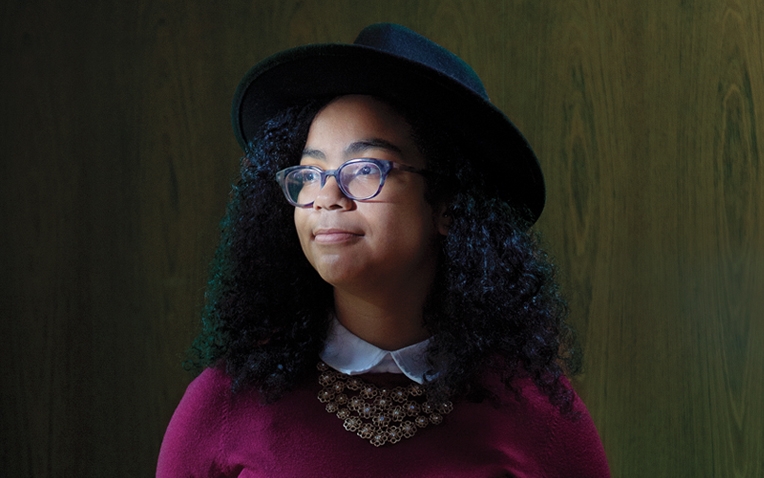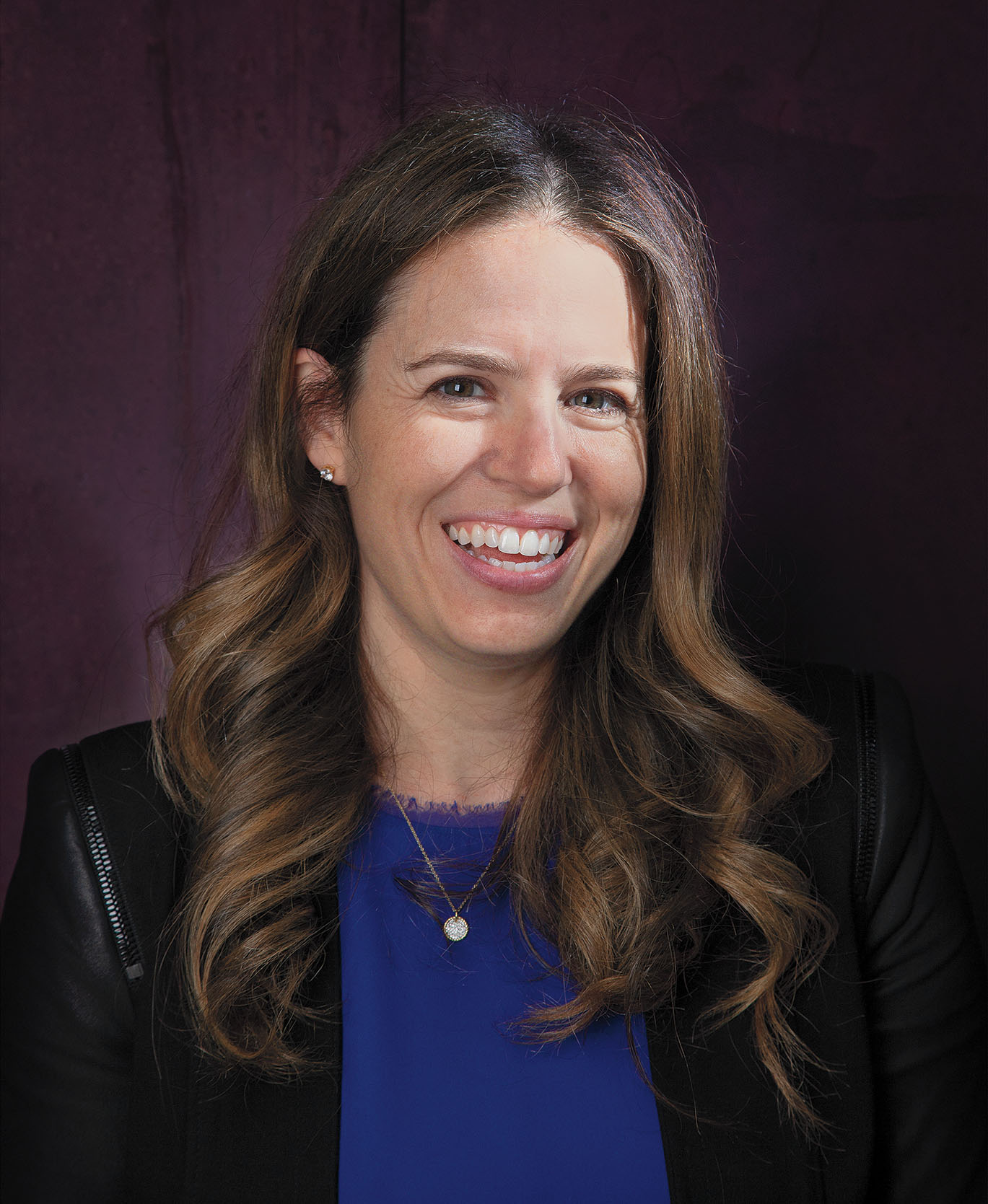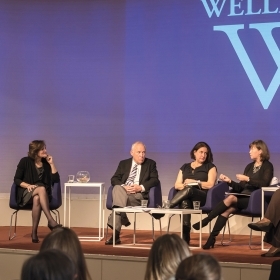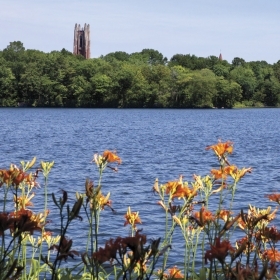Nhia Solari ’19
In July, the co-chairs of the College’s comprehensive campaign dedicated to the Wellesley Effect announced an extraordinary feat: The College had surpassed its ambitious $500 million goal, the largest ever set by a women’s college, and was concluding a full year ahead of schedule.
You can see the effects of the campaign all over campus, from the renovated field house and Pendleton West to the transformation of Acorns into a multicultural space to Global Flora, the new greenhouse currently growing on Science Hill. Some outcomes aren’t physical, but are no less consequential: $80 million was raised to support financial aid; Career Education underwent a massive and award-winning transformation; new programs like the Paulson Ecology of Place Initiative were created; faculty positions were endowed. And the effects of the campaign will echo long into the future, as projects now being planned, like the renovation and addition to the Science Center, are set in motion, and as intended gifts from bequests become available.
In the following pages, we highlight just a few members of the Wellesley community whose lives have been touched directly by the campaign, and who are each effecting change in the wider world, whether it’s by doing groundbreaking neurology research studying fruit flies’ flight patterns or helping to register Latinx voters in Washington, D.C. In short: stories about the Wellesley Effect.
Getting to Wellesley
Nhia Solari ’19
For Nhia Solari ’19 and Wellesley, it was love at second sight. The first time she toured campus, Solari, then a student at the High School for Math, Science, and Engineering at City College in New York City and a serious ballet dancer, was set on going to a school where she could double-major in dance and a science. Because Wellesley doesn’t have a dance major, she was skeptical—plus, it was raining that day. But after she was accepted, she returned to Wellesley for spring open campus weekend, and she fell head over heels.
“I was just, ‘This is the place. Oh, my God. I have to come here. I don’t care about anything else. This is where I want to come,’” Solari says. “All the people that I met at Wellesley were so nice to me and willing to help me, which is really strange coming from New York, because you don’t talk to strangers like that. But everyone was like, ‘Oh, are you lost? Can I show you how to get somewhere?’ … Everyone on campus was just so genuinely happy to meet me and just happy to be there in general.” It also helped that her student host took her to an AscenDance rehearsal, where she was intrigued by students of varying skill levels dancing and collaborating in a relaxed way.
Solari says she had always been very conscious about the cost of college, but her parents told her not to worry. “They said, ‘Be true to where you want to go. We’ll figure out how to make it work,’” she says. Happily, thanks to Wellesley’s generous financial-aid program, that wasn’t too difficult. “A lot of my other [college] options, I would have been about $50,000 in debt by the time I graduated. But the fact that I really loved Wellesley, and that it was one of my significantly more affordable options, was just even better than I could have imagined.”
The comprehensive campaign dedicated to the Wellesley Effect raised more than $80 million to support financial aid; today, nearly 60 percent of students receive financial aid, with an average annual grant of $47,000. Because of its well-funded financial-aid program, Wellesley can remain committed to its need-blind admission policy, enrolling students based on their skills, abilities, and promise, not their family’s income.
Solari’s promise has manifested at Wellesley in unexpected and creative ways. She’s a philosophy and geosciences double major—interests that were both sparked by courses she took by chance her first year—and has developed an interest in science communication. She played Toto in an AscenDance production of The Wizard of Oz retold as a ballet story. She spent last Wintersession on campus as a fellow at the Albright Institute. Through the Albright, she got a summer internship in Australia with the Nature Conservancy, working on a program that collaborates with women in the Solomon Islands on conservation projects. (She even traveled to the islands and witnessed baby sea turtles hatching.) She’s a first-year mentor this year, helping new students find their place at Wellesley. Her busy schedule also includes a job in the Office of Admission, leading tours on campus and helping prospective students find their “this is the place” moment—and offering reassurance that Wellesley can be within their reach, whatever their financial backgrounds. —LSM
A Creative Approach to Neuroscience
Sara Wasserman ’02, Kresa Family Assistant Professor of Neuroscience
Sara Wasserman ’02, the first Kresa Family Assistant Professor of Neuroscience, benefits from more than the endowed funds that support her salary; she also works directly with Kiren Kresa-Reahl ’87, the neurologist and surgeon whose family foundation established the professorship during the campaign.
“I’ve been at Wellesley two years now, and Kiren has come both years to speak with our students about what it’s like to be a neurologist,” says Wasserman. She and Kresa-Reahl are also collaborating to create case studies Wasserman will use in her introduction to neuroscience course. “We’re filming med students Kiren works with presenting the studies, such as, ‘We just met this patient on the side of the road, and she reported that she all of a sudden lost peripheral vision, and we can’t get to the hospital in time. We need your help to solve the problem.’” Wasserman’s students will role-play as medical residents trying to come up with a diagnosis.
This creative approach to teaching harks back to Wasserman’s dual major in neuroscience and theater studies. She says that one of the most important lessons she learned at Wellesley was to take risks—and sometimes to fail. “The first time I got to really fail in an academic setting was in a lab with [professor of neuroscience] Barbara Beltz—and then also in the theater. I think it’s really important—and I see with my students that it’s really challenging.”
But the willingness to fail is central to science, Wasserman says. “If you knew how everything was going to work out—this is something my postdoc advisor told me that I have passed along to my Wellesley students—it would be a factory, not a lab.”
In her lab, Wasserman and her students are studying the electrical and chemical communications in the brain that drive decision-making and, ultimately, behavior.
“If your external environment changes, you want to adapt to that,” says Wasserman. “But you also want to be able to maintain the behaviors that are going to help you survive. If your internal state changes, if you’re tired or thirsty or hungry, you want to change your behaviors so you can improve that situation—but you don’t want to change that so much that you don’t survive. We’re really interested in state-dependent decision-making and how can we have a brain that’s robust to changes, but also flexible.”
It turns out that the fruit fly, D. melanogaster, is an ideal model for examining these phenomena. “Fruit flies, amazingly, live very exciting lives,” says Wasserman. “They’re constantly having to update their external-internal states to generate appropriate, adaptive behavior that’ll help them survive. And we’re finding that a lot of the way the fly brain does things is quite similar to our brains. So it’s quite humbling.”
Wasserman’s students do hands-on work in her lab, even building from scratch the flight simulators they use to analyze fruit fly reactions to stimuli.
“Being at a place like Wellesley helps train students to really think about questions from lots of different angles,” says Wasserman. “How do we interpret the data? How might you put this into a bigger-picture context, and what would the next steps be? Is this answering the question that we asked?” —CG
A New Outlook for Fitness and Wellness
Becky Kimball, Butler Director of Sports Performance and Fitness
Rebecca “Becky” Kimball likes to keep her finger on the pulse of the Wellesley community. And as the Butler Director of Sports Performance and Fitness, she does that both literally and figuratively.
Kimball arrived at the College in the summer of 2013, the first to fill the position, which was made possible by a gift from Alice Lehmann Butler ’53 and her husband, John. Kimball has overseen a lot of changes in the past five years, seeking input from the community all along the way. The field house was renovated extensively. The 4,600-square-foot fitness center was created (and filled with equipment she chose). The boathouse was also completely overhauled and revitalized, thanks to another gift from the Butlers. And those are just the large-scale physical changes.
“Our numbers for group exercise have exploded,” Kimball says. “We had seven instructors when I first arrived, with seven classes a week. [Last year,] I had 18 instructors with eight shadows, and we taught 20 classes a week.” The group-exercise classes are student-led, and Kimball created a shadow program to help train instructors. “It’s very rare for colleges to have students teaching students. … There’s a leadership quality to it, [and students] definitely take ownership of their class and build a reputation for their class,” Kimball says.
Those classes range from spin and Zumba to yoga and Pilates—and more. “Fitness is expanding on campus,” Kimball says, and she attributes that to many of the physical improvements that have taken place. They have “changed the whole outlook of fitness and wellness on campus. It’s given students opportunities that they would never have had [in the past].” Opportunities that include the simple pleasures of hitting the treadmill in an air-conditioned space as well as the unique joy of sunset yoga at the Butler Boathouse.
The list goes on, and Kimball wants to keep it that way. In addition to implementing and overseeing these programs, she’s looking ahead to how the College can better meet the fitness and wellness needs of the entire community. Kimball oversees the College’s 13 varsity teams, group fitness classes, student instructors, and the fitness center, and she serves as a Physical Education, Recreation, Athletics assistant professor of the practice, teaching intro to triathlon training and sports performance training. She also co-chairs the Wellness Outreach Collaborative.
“Our Wellness Collaborative is always working on something new,” Kimball says. “Right now, we are working on implementing our own ‘wellness wheel’ on campus that’s adapted to Wellesley students.” They are also investigating ways to bring fitness to the East Side of campus, where students can feel left out, especially during the winter months when the trek across campus is … less than appealing. A new “fitness on demand” service is being considered that would allow students to access virtual classes on their own schedule.
Kimball is excited to implement her vision for the department. “The direction that I wanted to go with fitness is teaching our students how to be healthy and safe and own the space that they’re in,” she says. With these investments in the department and its physical spaces, Kimball says, “it’s changed the pulse of fitness on campus.” —JEG
A Way to Explore a Passion
Juniper Ozbolt ’21
Juniper Ozbolt ’21 grew up in Pahoa, a small, remote town on the east side of the Big Island of Hawai‘i known for its lush landscape and hippie culture. Ozbolt and her parents moved from Ohio when she was 2, and she grew up steeped in native Hawaiian culture and language. But when it came time for college, Ozbolt didn’t apply to any local schools. She was eager for opportunities outside Hawai‘i, and after a semester program in Maine for girls during high school, she was intrigued by women’s colleges. By the end of her first year at Wellesley—a challenging time for Ozbolt, a first-generation college student who set foot on campus for the first time during orientation—she yearned to go home for the summer. She hoped to give back to her community, explore her interest in indigenous culture, and, crucially, support herself financially.
Enter Career Education, a total reimagining of Wellesley’s career services that debuted in 2016, thanks to a historic $50 million gift from two alumnae, which launched the comprehensive campaign dedicated to the Wellesley Effect. Career Education is a part of Wellesley students’ college experience from their first year, when they’re assigned a career mentor. The program helps them connect with opportunities, individuals, and funding. Thanks to the Joan Freed Kahn ’51 Service Program Service Opportunity Stipend through Career Education’s grants program to support student-identified internships, Ozbolt was able to return to Hawai‘i to pursue two opportunities.
First, she had an unpaid internship at the Hilo Medical Center Foundation, a nonprofit organization that raises funds and support for the medical center and also does projects that benefit the surrounding community. While there, Ozbolt created materials for resident physicians at the Hilo Medical Center, letting them know about attractions and activities in the area. She also helped make presentations for local high-school students on applying to college.
Ozbolt also took part in the Wahi Kupuna Internship Program in Ke‘ei, South Kona, which introduces undergraduates—predominantly Native Hawaiians attending college in Hawai‘i—to the field of cultural-resource management and field research. “There’s long been this rift between Western archaeologists and Native Hawaiian communities, because Western archaeologists come into Hawai‘i and make decisions for the community without listening to their needs. They don’t communicate with community members and ask them, ‘What do you think this was used for? What’s the proper protocol for us to enter this space that is a very sacred religious space for Native Hawaiians or is culturally significant?’” Ozbolt says. Last summer, the program focused on ancient trail systems in Ke‘ei. Ozbolt mapped the ancient trails, conducted ethnographic interviews with local Native Hawaiians about their connection to the land, and documented features like salt pans, which are modified rock basins used to evaporate salt from sea water.
“This experience was really impactful for me, and it has allowed me to see a viable way I can give back to my community while still being passionate about what I want to do, and make a living wage,” says Ozbolt. “And this is just my first summer at Wellesley. I’m so excited to see what my other summers are going to be like.” —LSM
An Internship Where the Action Is
Diana Cruz ’19
For the Wellesley juniors participating in the 75th Wellesley in Washington Internship Program, summer 2018 was quite a moment to work in the nation’s capital.
“Living in Washington was like coming to the center of it all, all the political turmoil that was happening,” says Diana Cruz ’19. “Our dorm was a 10-minute walk from the White House.”
Wellesley in Washington began during World War II, when the College closed in the winter of 1943 to save fuel. A political science professor arranged for 15 students to volunteer in various government agencies in Washington, D.C., during the break. The program was so successful that it continued in summer 1944—and has been sending Wellesley students to the city every summer since.
An alumna of both the College and Wellesley in Washington (she worked at the State Department) has created an endowment to support the internships, which will be renamed the Zoë Sarbanes Pappas ’66 Wellesley-in-Washington Internship Program. Pappas has designated one of the 20 internships her gift supports in honor of her late niece, Jill Wrigley ’87.
Students work around the city, from Capitol Hill to museums, hospitals, and nonprofits. The interns receive stipends for living expenses and are housed at George Washington University. Last summer, students worked in congressional offices, at the U.S. Court of Federal Claims, the Children’s Defense Fund, the International Labor Rights Forum, the Smithsonian American Art Museum, the National Bureau of Asian Research, and more.
Professor of Political Science William Joseph, who chairs the Wellesley in Washington Internship Program Committee, says, “This is a formative way to ground students’ academic experience at Wellesley where the action is in the real world. They bring a whole new perspective when they return to campus as seniors; the experience energizes them to understand the practical and the political.”
Cruz, a Spanish major, interned for Voto Latino, a nonprofit that seeks to empower Latinos to be agents of change and build a more inclusive democracy. “I was interested in nonprofit organizations that were advocating specifically for Latinx youth, because I’m a Latina,” she says.
At Voto Latino, Cruz, who is bilingual in Spanish and English, was a field intern, working on events and doing voter registration. She also helped, from D.C., to prepare for a rally in Texas at a center that held children separated from their families at the Mexican border. “I was recruiting volunteers, talking to people who were going to be there, setting up dates and contacts,” she says. “I have been super-attached to this issue [immigration] for so long, because my parents are both immigrants from Mexico. … It was really nice to know that people are interested and really want to help the families and want to help change these crazy policies.”
She was impressed by the energy and activism she encountered in D.C. “There was a protest or rally happening almost every week, and so many people would show up,” says Cruz. “It was easy to get involved, just to go up to someone at a protest holding a mic and be on their Facebook Live talking about what you care about.” —CG












We ask that those who engage in Wellesley magazine's online community act with honesty, integrity, and respect. (Remember the honor code, alums?) We reserve the right to remove comments by impersonators or comments that are not civil and relevant to the subject at hand. By posting here, you are permitting Wellesley magazine to edit and republish your comment in all media. Please remember that all posts are public.